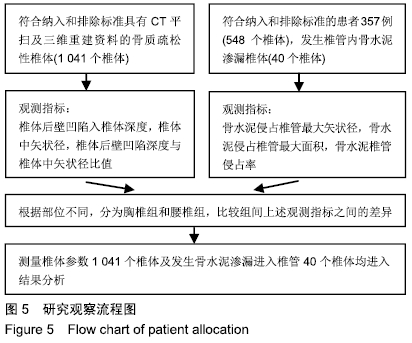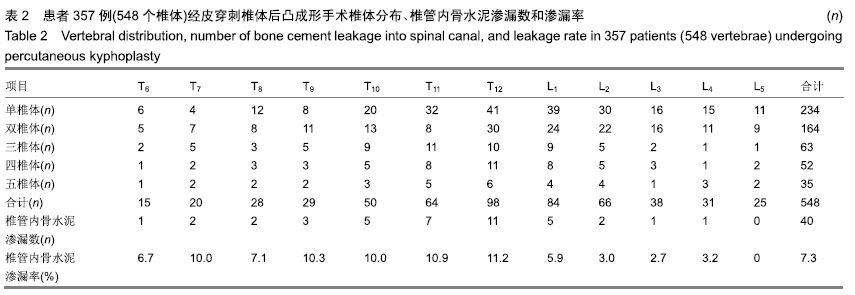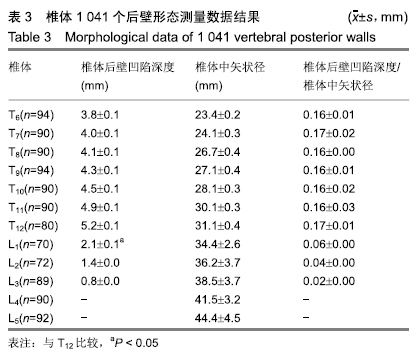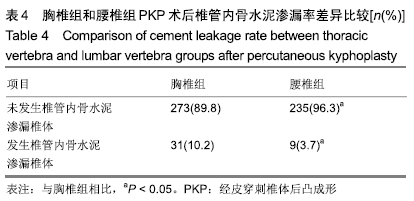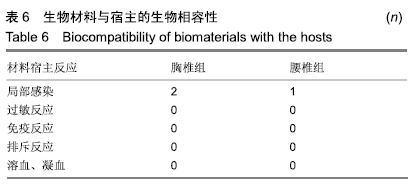[1] KARMAKAR A, ACHARYA S, BISWAS D, et al. Evaluation of percutaneous vertebroplasty for management of symptomatic osteoporotic compression fracture. J Clin Diagn Res. 2017;11(8): RC07-RC10.
[2] LIEBERMAN IH, DUDENEY S, REINHARDT M K, et al. Initial outcome and efficacy of "kyphoplasty" in the treatment of painful osteoporotic vertebral compression fractures. Spine. 2001;26(14): 1631-1638.
[3] KAN SL, YUAN ZF, CHEN LX, et al. Which is best for osteoporotic vertebral compression fractures: balloon kyphoplasty, percutaneous vertebroplasty or non-surgical treatment? A study protocol for a Bayesian network meta-analysis. BMJ Open. 2017; 7(1):E012937-E012941.
[4] PHILLIPS FM, HO E, CAMPBELLHUPP M, et al. Early radiographic and clinical results of balloon kyphoplasty for the treatment of osteoporotic vertebral compression fractures. Spine; 2003,28(19):2265-2267.
[5] MA XL, XING D, MA JX, et al. Balloon kyphoplasty versus percutaneous vertebroplasty in treating osteoporotic vertebral compression fracture:grading the evidence through a systematic review and meta-analysis. Eur Spine J. 2012;21(9):1844-1859.
[6] 周宏斌,秦小容,屈万明,等.不同方法治疗老年骨质疏松性椎体压缩骨折的临床疗效分析[J].重庆医学,2016,26(6):802-804.
[7] 李惠民,陈银河,申才良.经皮椎体后凸成形术治疗骨质疏松性椎体压缩骨折远期并发症的Meta分析[J].中国脊柱脊髓杂志,2017,29(7): 718-722.
[8] 王松,杨剑,杨函,等.侧卧位单侧经横突-椎弓根入路椎体后凸成形术治疗骨质疏松性椎体压缩骨折的疗效[J].实用医学杂志,2017, 33(33):3905-3909.
[9] ZHAN Y, JIANG J, LIAO H, et al. Risk factors for cement leakage after vertebroplasty or kyphoplasty: a meta-analysis of published evidence. World Neurosurg. 2017;101(6):633-642.
[10] YEOM JS, KIM WJ, CHOY WS, et al. Leakage of cement in percutaneous transpedicular vertebroplasty for painful osteoporotic compression fractures. J Bone Joint Surg Br. 2003;85(1):83-89.
[11] GARFIN SR, YUAN HA, REILEY MA. New technologies in spine: kyphoplasty and vertebroplasty for the treatment of painful osteoporotic compression fractures. Spine(Phila Pa1976). 2001; 26(14):1511-1515.
[12] SHAWKY A, EZZATI A, GOVINDASAMY R, et al. Kyphoplasty for osteoporotic vertebral fractures with posterior wall injury. Spine J. 2017;18(7):1143-1148.
[13] SUN K, LIU Y, PENG H, et al. A comparative study of high-viscosity cement percutaneous vertebroplasty vs. low-viscosity cement percutaneous kyphoplasty for treatment of osteoporotic vertebral compression fractures. J Huazhong Univ Sci Technolog Med Sci. 2016;36(3):389-394.
[14] LIU T, LI Z, SU Q, et al. Cement leakage in osteoporotic vertebral compression fractures with cortical defect using high-viscosity bone cement during unilateral percutaneous kyphoplasty surgery. Medicine. 2017;96(25):E7216-E7221.
[15] JIACHEN L, LIE Q, CHANGQING J, et al. Bone cement distribution is a potential predictor to the reconstructive effects of unilateral percutaneous kyphoplasty in OVCFs: a retrospective study. J Orthop Surg Res. 2018;13(1):140-146.
[16] CHEN H, TANG P, ZHAO Y, et al. Unilateral versus bilateral balloon kyphoplasty in the treatment of osteoporotic vertebral compression fractures. Orthopedics. 2014;37(9):e828-e835.
[17] NIEUWENHUIJSE MJ, VAN ERKEL AR, DIJKSTRA PD. Cement leakage in percutaneous vertebroplasty for osteoporotic vertebral compression fractures: identification of risk factors. Spine J. 2011; 11(9):839-848.
[18] HARRINGTON KD. Major neurological complications following percutaneous vertebroplasty with polymethylmethacrylate: a case report. J Bone Joint Surg Am. 2001;83-A(7):1070-1073.
[19] CHEN J, CHEN Y, ZHANG Z S, et al. Retrospective analysis of cement leakage in percutaneous kyphoplasty for osteoporotic vertebral compression fractures. Medicine. 2019,98(10): e14793-e14798.
[20] DING J, ZHANG Q, ZHU J, et al. Risk factors for predicting cement leakage following percutaneous vertebroplasty for osteoporotic vertebral compression fractures. Eur Spine J. 2016;25(11):3411-3417.
[21] GAO C, ZONG M, WANG WT, et al. Analysis of risk factors causing short-term cement leakages and long-term complications after percutaneous kyphoplasty for osteoporotic vertebral compression fractures. Acta Radiol. 2018;59(5):577-585.
[22] ZHAN Y, JIANG J, LIAO H, et al. Risk factors for cement leakage after vertebroplasty or kyphoplasty: a meta-analysis of published evidence. World Neurosurg. 2017;101(5):633-642.
[23] KAUR K, SINGH R, PRASATH V, et al. Computed tomographic-based morphometric study of thoracic spine and its relevance to anaesthetic and spinal surgical procedures. J Clin Orthop Trauma. 2016;7(2):101-108.
[24] TAN SH, TEO EC, CHUA HC. Quantitative three-dimensional anatomy of cervical, thoracic and lumbar vertebrae of Chinese Singaporeans. Eur Spine J. 2004;13(2):137-146.
[25] SCOLES PV, LINTON AE, LATIMER B, et al. Vertebral body and posterior element morphology: the normal spine in middle life. Spine.1988;13(10):1082-1086.
[26] GOUZIEN P, CAZALBOU C, BOYER B, et al. Measurements of the normal lumbar spinal canal by computed tomography. Surg Radiol Anat. 1990;12(2):143-148.
[27] RAPAŁA K, CHABEREK S, TRUSZCZYŃSKA A, et al. Assessment of lumbar spinal canal morphology with digital computed tomography. Ortop Traumatol Rehabil. 2009;11(2): 156-163.
[28] 王高举,谢胜荣,杨进,等.老年骨质疏松性椎体压缩骨折和中青年胸腰椎骨折患者椎弓根宽度的CT观察[J].中国脊柱脊髓杂志,2016, 26(12):1076-1081.
[29] RYU KS, PARK CK, KIM MK, et al. Single balloon kyphoplasty using far-lateral extrapedicular approach: technical note and preliminary results. J Spinal Disord Tech. 2007;20(5):392-398.
[30] WANG S, WANG Q, KANG J, et al. An imaging anatomical study on percutaneous kyphoplasty for lumbar via a unilateral transverse process-pedicle approach. Spine (Phila Pa 1976). 2014;39(9):701-706.
[31] 杨惠林,刘强,唐海,等.经皮椎体后凸成形术的规范化操作及相关问题的专家共识[J].中华医学杂志,2018,98(11):808-812.
[32] HEINI P, ORLER R. Kyphoplasty for treatment of osteoporotic vertebral fractures. Eur Spine J. 2004;13(3):184-192.
[33] BELKOFF SM, MARONEY M, FENTON DC, et al. An in vitro biomechanical evaluation of bone cements used in percutaneous vertebroplast. Bone. 1999;25(2 Suppl):23S-26S.
[34] REBOLLEDO BJ, GLADNICK BP, UNNANUNTANA A, et al. Comparison of unipedicular and bipedicular balloon kyphoplasty for the treatment of osteoporotic vertebral compression fractures a prospective randomised study. Bone Joint J. 2013;11(3): 401-406.
[35] SONG BK, EUN JP, OH YM. Clinical and radiological comparison of unipedicular versus bipedicular balloon kyphoplasty for the treatment of vertebral compression fractures. Osteoporosis Int. 2009;20(10):1717-1723.
|

